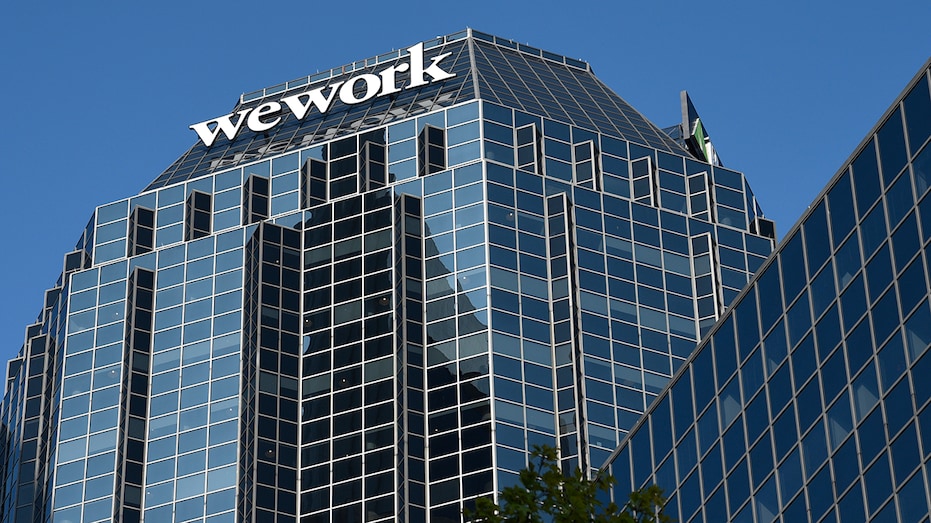Check out what’s clicking on FoxBusiness.com.
WeWork, which had one of the most spectacular IPO implosions in recent years, is trying to go public again—and some of the factors that worried regulators on the first deal are back again.
Stocks in this Article
$12.07
-1.09 (-8.28%)
WeWork isn’t doing an initial public offering this time, but merging with a special-purpose acquisition company, or SPAC. Rules around SPACs are looser than for IPOs, giving WeWork more leeway to tout its future.
The shared-office provider is expected to merge with a SPAC called BowX Acquisition Corp. later this year. As the two entities promoted the deal to investors, they painted an optimistic scenario for the company’s growth and profitability.
WEWORK DISCLOSES $3.2B LOSS IN 2020 AS IT SEEKS SPAC DEAL
BowX’s chairman described WeWork in a call with investors as a $5 billion revenue company, though that figure is a projection rather than a current number. When describing WeWork’s size, the company counted units that WeWork doesn’t own directly.
WeWork is predicting a rapid recovery from the pandemic downturn, which hit its business particularly hard because few people were using offices, much less shared space, and because it was still on the hook for long-term leases. The company is also using a new profit measure that shows higher margins than it claimed in late 2019.

WeWork, which had one of the most spectacular IPO implosions in recent years, is trying to go public again—and some of the factors that worried regulators on the first deal are back again. (Photo by Robert Alexander/Getty Images)
In the run-up to the IPO, the Securities and Exchange Commission told WeWork to change certain profit and growth measures that it was using. The recent investor presentation by BowX has “echoes of the company’s approach in 2019,” said Minor Myers, a law professor at the University of Connecticut who specializes in corporate finance. “The SEC could push back hard again,” he said, unless WeWork tones down these claims in its official filings with regulators, expected later this month.
A WeWork spokeswoman said the company “will always work with the SEC to ensure our disclosures comply with their requirements.” An SEC spokesman declined to comment. BowX didn’t respond to requests for comment.
SPACs raise money as a shell company in an IPO and then look for a private business to combine with, a deal that transforms the target into a public company. Many of these targets are startups, often with little revenue and no profits, that have used optimistic projections to promote their deals.
SPACs have displaced traditional IPOs as the main route for private companies to list on stock exchanges. SPACs accounted for 75% of all IPOs from January through March, more than double their 35% share for the same quarter last year, according to data provider Dealogic.
The SEC earlier this month warned companies going public through SPACs against making unrealistic projections. The agency’s concern comes after several young companies, including electric-vehicle startups, touted plans to reach multibillion-dollar annual revenues in just a few years.
CLICK HERE TO READ MORE ON FOX BUSINESS
SEC rules limit companies doing IPOs from making projections or talking publicly. Both are permissible in SPAC deals. Backers of the SPAC process say the rules give startups a chance to chart their visions to investors, which critics say is unnecessarily difficult in IPOs.
WeWork’s proposed deal, valuing it at $9 billion including debt, is due to be voted on by BowX shareholders later this year. Trading in BowX on March 26, the day the deal was announced, was more than 100 times the volume the day before, and the shares closed at $11.71, up 13% from their $10.33 opening. On Friday, they finished at $12.07.
The WeWork call with investors included its chief executive officer, Sandeep Mathrani, and BowX’s chairman, Vivek Ranadivé, who called WeWork a $5 billion revenue company “just with their existing capacity.” Revenue isn’t projected to go over $5 billion a year until 2023, according to the company’s slides.
The pitch describes the company as a “massive growth opportunity,” with “850+ locations,” more than a million workstations and over 450,000 memberships. Those tallies include WeWork’s China and India operations, which aren’t part of the entity that is being merged and aren’t included in its financial statements, according to the small print on the slides. A person close to WeWork said including the India and China franchises gave a sense of the reach of the portfolio and platform.
The growth forecast assumes that occupancy of WeWork buildings doubles from 47% at the end of last year to 95% in 2024. Mathrani said occupancy could rise further because the company’s membership model means the same space can be sold more than once. “You can actually go over 100%,” he said.
In 2019, the SEC questioned that view. “Tell us how your assumed workstation utilization rate of 100% is realistic,” the agency asked the company in a letter reviewed by The Wall Street Journal. The prediction was dropped by WeWork.
WeWork has long been criticized, including by the SEC before the IPO, for presenting its numbers in a way that converted its loss-making business into something that appeared to be profitable. The company seems to be doing something similar today.
GET FOX BUSINESS ON THE GO BY CLICKING HERE
As many companies do, WeWork used a measure that excluded basic costs such as administrative and marketing expenses, and focused on the expected performance of sites when they were up and running.
Today, the company calls the measure “mature building margin,” which it puts at 27% based on 2019 figures. The number is calculated for buildings open a year or more and excludes various “expenses that are necessary to operate our buildings but not directly tied to an individual building.”
Under different leadership, WeWork previously reported significantly lower margins for a similar metric. In a fall 2019 investor slideshow, after the failed IPO and ouster of WeWork’s co-founder and CEO, Adam Neumann, the company said its mature “location contribution margin” was 21% for buildings open more than two years in the first half of 2019.
A person close to the company said WeWork has changed a lot since 2019, and the two metrics aren’t directly comparable.


